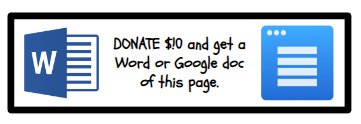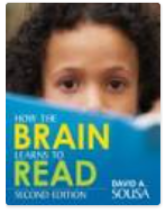

Encoding and Decoding
The following page numbers refer to David Sousa’s How the Brain Learns to Read, 2nd Edition.
- Phonics instruction was the earliest method for teaching reading. Children were taught letter names and simple syllables to construct words. This analytical approach used bits of words to build syllables, then words, and meaningful phrases (p. 69).
- Choral reading is more global and emerged in the 20th century (p. 69).
- The whole-word approach put little emphasis on phonics and emphasized recognizing entire words with meaningful reading units (p. 70).
- Today we use balanced literacy, which combines phonics with enriched reading (p. 70).
- The reason for whole-word instruction was the irregularities in the pronunciation of common words ~ pint vs. hint and have vs. gave ~ letter to phoneme correspondences are not reliable; therefore, we should memorize whole words, not parts. The whole word also promotes comprehension early in reading. Words have meaning; speech sounds do not (p. 70).
- Whole language (Smith and Goodman 1971) is a psycholinguistic approach. Reading is a guessing game in which readers determine meaning through cueing systems in rich literature. Phonics taught separately is too dull. Whole language is called the literature-based method today (p. 70).
- Since the Common Core, National Research Council, and National Reading Panel ~ reading should be a balanced and comprehensive approach that includes phonics and an enriched text (p. 71).
- Reading programs need to be based sufficiently on scientific research to meet the No Child Left Behind Act requirements of 2001 (p. 71).
- The Balanced and Comprehensive Approach is based on the following: no one reading program is the best for all, children need to develop phonemic awareness and master the alphabetic principle, phonics should not be taught separately and through drill and rote memorization, phonics should be taught to develop spelling strategies and word analysis skills, read for meaning, enriched literature develops a positive disposition towards reading and sets their mind to think imaginatively and creatively (p. 71).
- People are concerned about assessments to accompany Common Core (p. 71).
- Factors affecting a pre-reader’s later literacy skills in decoding, comprehension, and spelling: alphabet knowledge (names and sounds), phonological awareness, phonological memory, writing and writing name, rapid naming of objects and colors, and rapid naming of letters and digits (p. 72).
- The predictive power of print knowledge and visual processing is weak (p. 71).
Successful instructional strategies (p. 73):
- Code-focused interventions: interventions designed to teach cracking the alphabetic code ~ getting children to detect and manipulate sounds through rhyming.
- Shared reading: read books to children and make the sharing interactive.
- Parent and home programs: teach parents instructional techniques to use at home. The most significant impact is on vocabulary development.
- Preschool/Kindergarten programs
- Language enhancement interventions: improving oral language skills, frequency of word use, and improving the average length of their statements.
- Research shows that SES, age, race, and ethnicity are not factors in filling the gap (p. 74).
- Reading is a learned skill. Therefore, programs must reflect what scientists have learned about how we acquire skills (p. 74).
Scientific learning elements of any skill (p. 74-75):
- Motivation/attention: focus and mental effort to sustain it. Technology should not be a dead-end but a motivational strategy to achieve a goal.
- Intensity: an intense focus on a new skill allows the brain to build more neural support for that skill in a short period (if you plan to run a marathon, occasional jogging will not help ~ you need intensity).
- Practice: students must be repeatedly exposed to and process the learned material. Practice makes permanent ~ be sure that the learning stored is correct. Research shows that the more a person reads, the better that person will be at reading at any age and level of proficiency.
- Cross-training: learning any skill is easier if supported by other skills the student already knows or is learning. Unrelated neural networks establish connections. For example, accomplished reading requires the reader to be proficient in spoken language fluency and comprehension.
- Adaptivity: the teacher needs to assess the student’s current skill level and adapt the new instruction accordingly. If it’s too hard, the learner is frustrated. Monitor progress in adapting instructional strategies.
- Awareness of Skill Level: success in decoding unfamiliar words empowers them once they know the alphabetic principle.
- fMRI and other brain-scanning technology continue to offer new insights into how the brains of the beginning, skilled, and struggling readers differ. Intensive interventions with struggling readers changed their fMRI images to resemble typical readers (p. 76).
- Writing to Read: Evidence of How Writing Can Improve Reading (Graham and Hebert, 2010) found that teaching writing strengthens students’ reading skills, and increasing writing improves students’ reading (p. 76).
- Reading involves two significant processes – decoding and comprehension. Successful decoding entails phonemic awareness, phonics, and fluency. Comprehension requires a developed vocabulary, interaction with the text, and a teacher trained in comprehension strategies (p. 77).
- Phonemic awareness and letter knowledge are the best predictors of how well children learn to read during their first two years of instruction. Even for middle and high school students, phonemic awareness is a good predictor of their ability to read accurately and quickly (p. 78).
- Phonemic awareness ~ the first step in mastering the alphabetic principle, the ability to map out letters onto the spoken sounds of language. As children’s mapping skills improve, they can read faster and with greater comprehension (p. 78).
- Phonemic awareness helps children learn to spell (p. 78).
- Phonemic awareness is most effective when children are taught to manipulate phonemes while handling cutouts of the letters that represent those phonemes (p. 78).
- Learning how to blend letters with phonemes helps students READ words, and learning to segment letters with sounds helps students SPELL words (p. 78).
- Phonemic awareness is most effective when it focuses on only 1 or 2 types of phoneme manipulation rather than several so that the children can master them (p. 78).
- Brain imaging studies have shown, with phonemic awareness teaching, that effective practice can build new neural circuits. After children are introduced to new letter-sound relationships, additional practice is necessary to ensure that the learning is committed to long-term memory (p. 78).
- Brain imaging also found that learning to read depends on mapping the letters and the spellings of words onto the sounds of speech and speech units they represent to develop the visual word form area (p. 78).
- Phonics instruction teaches the relationship between phonemes of spoken language and the graphemes of written language and how to use these relationships to read and write words (p. 79).
- Please see page 79 in David Sousa’s How the Brain Learns to Read for a “How to Teach Phonemic Awareness” chart.
- Phonics instruction teaches children a system of remembering how to read words (p. 80).
- Special education and Title One programs benefit from phonics-based programs (p. 80).
- An examination of 22 studies showed that phonics instruction resulted in significantly higher achievement for elementary students, especially minority students (p. 80).
- Systematic and explicit phonics instruction improves kindergarten and grade 1-word recognition and spelling. However, the effects of instruction in grades 2 through 6 are limited to improving their oral text and word reading skills. Beyond grade 6, it is generally not productive for most students (p. 80).
- Systematic instruction significantly improves reading comprehension based on research (p. 80).
- Systematic instruction is effective for various economic and social levels (p. 80).
- Systematic instruction benefits those with difficulty learning to read and at risk of developing reading problems (p. 80).
- Systematic instruction is most effective when introduced in kindergarten or grade 1 (p. 80).
- Please see pages 80-82 in David Sousa’s How the Brain Learns to Read for a “How to Teach Phonics” chart.
- There are some spelling rules in English, but it takes the brain more areas to remember and encode complex exceptions ~ those whose pronunciations stray from what is expected, such as -tion, -ould, -ough (p. 82).
- Spelling is closely related to reading because it involves breaking apart a spoken word into its sounds and encoding them into letters representing each sound. Thus, while learning to read, children learn how to spell (p. 82).
- Pronunciation in invented spelling is very close to the intended word. Invented spelling assists in the development of reading and writing (p. 82).
- Studies show that invented spelling is a reliable measure of reading achievement. Invented spelling encourages children to use an analytical approach to spelling and facilitates phonological and orthographic knowledge (p. 82-83).
- Writing may be an easier way to literacy than reading. Writing is the reverse of reading. Writing may be a simpler task because it involves going from sounds in the child’s head, which is already known and automatic, to letters, rather than from unknown letters in reading to what is known (p. 83).
- With appropriate teacher intervention, invented spellings gradually come closer to conventional forms. Thus, spelling errors should not be seen as an impediment to writing but as an indication of a child’s thought processes while making sense of letter-sound relationships (p. 83).
- Teachers should use strategies to help children transform invented spelling into conventional spelling so the errors are not stored in long-term memory (p. 83).
- Texting does not lead to poor spelling. On the contrary, texting may be helpful because the child’s brain needs to perform a mental word analysis to decide how best to abbreviate the word. This act requires neural circuits to remember the word’s correct spelling to convert it to textese (p. 83).
- Children move through 5 stages when developing spelling skills. Brain networks map sounds to letters and look for patterns to remember, which will help with encoding and decoding in the future (p. 84).
- Stages 1 and 2 deal with sound, stages 3 and 4 deal with patterns, and stage 5 deals with prefixes and suffixes (p. 84).
- Please see pages 84-86 in David Sousa’s How the Brain Learns to Read for a “How to Teach Spelling” chart.
- Students’ reading performance improves significantly when teachers ask students to write about their reading. In addition, it teaches students to be better writers and increases the number of times students write (p. 87).
- Summary writing, note-taking, answering questions, and extended response positively impact reading competence. Teaching reading and writing together helps students develop literacy skills and knowledge (p. 87).
- Fluency: the ability to read a text with speed, accuracy, and expression. It helps the reader focus on the content (p. 87).
- Children without fluency can’t recall what they’ve read due to their limited working memory capacity. Practicing reading helps with fluency (p. 87).
- Fluency bridges the gap between word recognition and comprehension. With practice, word recognition and comprehension co-occur (p. 87).
- The fluency of even skilled readers slows down when encountering unfamiliar vocabulary or topics (p. 88).
- To read with expression, readers must divide sentences into meaningful chunks that include phrases and clauses (p. 88).
- Automaticity: fast and effortless word recognition that comes after much reading practice. It does not refer to reading with expression (p. 89).
- Monitored repeated oral reading improves reading fluency and overall reading achievement (p. 89).
- Studies have found that students’ oral reading fluency in first, second, and third grades is a reliable predictor of how well they score on high-stakes reading comprehension tests at the end of third grade (p. 89).
- Fluency is not a direct result of proficiency in word recognition. Instead, fluency is a separate component developed through instruction (p. 90).
- Informal reading inventories, running records, and miscue analysis are appropriate measures for finding students’ issues with word recognition but are not fluency measures. Calculating words read correctly per minute is a more suitable measure (p. 90).
- The best readers read the most, and the poorest readers read the least, so class time spent on independent silent reading is not a good use of time because of the minimal guidance and feedback (p. 90).
- Studies have shown no correlation between silent reading and improved fluency or comprehension (p. 90).
- Independent reading does build a reader’s vocabulary. Children who read for 10 minutes/day read over 600,000 words each year than children who do not. 20 minutes/day increases the time to over 2 million words/year (p. 90).
- Please see pages 90-92 in David Sousa’s How the Brain Learns to Read for a “How to Teach Fluency” chart.
- The alphabetic principle does not come naturally to most children. Therefore, instructional techniques that teach this principle through phonological awareness are most effective (p. 93).
Check out these links for more information!
![]()


